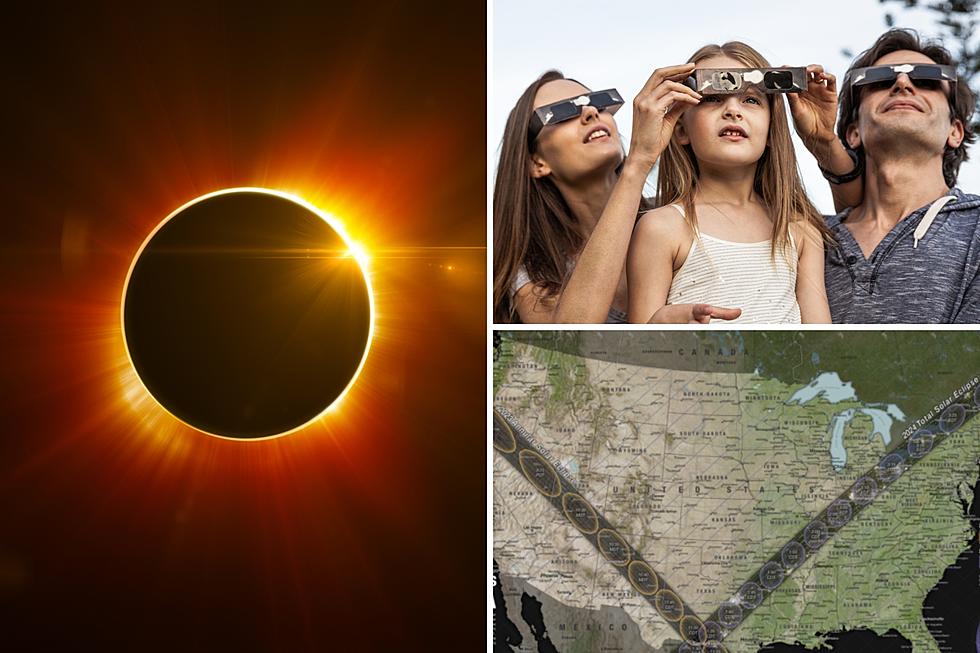
Awesome annular solar eclipse partially visible from NJ next week
A rare celestial event is coming up next week: An annular solar eclipse. And it will be partially visible from New Jersey. While this is not "the big one" — a total solar eclipse — it's still a cool event. Especially since the appearance of the sun during such an event has been described as "a ring of fire". Here are the details, as the cosmic ballet goes on.
What is a solar eclipse?
A solar eclipse happens when the moon passes directly between the Earth and the sun. Truly an awesome display, eclipses have long been considered an omen or supernatural.
There are three types of solar eclipses: Total, partial, and annular. There is also a "hybrid" eclipse form, which is a combination of the total and annular types.
Eclipses of the sun occur between two and five times a year. This will be the second of two in 2023. (The first was in April, and not visible from North America.)
What is an annular solar eclipse?
During a total solar eclipse, the moon's relative size is large enough to obscure the entire moon. Hence, a narrow corridor on the earth's surface falls in the "path of totality" and experiences a few minutes of eerie darkness.
However, during an annular eclipse, the moon is at the farthest point in its orbit. So it appears smaller than the sun. So the moon does not cover the entire sun — only shrouding about 91% of it. That is why it is called a "ring of fire" eclipse, as the moon appears as a dark spot surrounded by the blazing outer edge of the sun. (The word "annular" literally means "ring".)
When is it?
Mark your calendar for the afternoon of next Saturday, October 14, 2023. According to Space.com, the effects of the eclipse will be visible for a few minutes surrounding 1:22 p.m. Eastern Daylight Time.
What will you see?
Unfortunately, New Jersey falls outside of the prime eclipse viewing area this time around. A stretch from Oregon to Texas will have front row seats to the "ring of fire".
New Jerseyans will only see the sun about 20 to 30 percent obscured during the eclipse - like the sun has a "bite" taken out of it. Of course, that is only if the weather forecast cooperates — clouds and rain could completely ruin the show.
No worries if skies are cloudy or want to experience the entire show. NASA will be livestreaming the entire eclipse from New Mexico and Texas.
Can you stare directly at the sun?
No, please don't risk permanently damaging your eyesight by staring at the flaming ball of gas in the sky. You probably wouldn't see much with the naked eye anyway, since the bright sun will only be partially hidden in NJ.
But with an appropriate solar filter — like those infamous "eclipse glasses" made popular during the 2017 total solar eclipse — you can look right at the sun.
Or, if you want to go old-school, you could make a pinhole projector to view the eclipse.
For cameras, including both professional photo and video lenses and smartphones, you may have to adjust your settings to capture such a contrasting bright/dark image.
Some additional safety tips regarding eclipse glasses:
—Make sure they are from a reputable manufacturer and sales source and are marked with ISO 12312-2.
—A proper solar filter should be so dark that when looking through it, you should not see much more than the sun.
—If your filter is scratched, loose, or damaged, do not use it.
—Only remove your eclipse glasses when safe to do so: When you are not looking at the sun anymore, or during the brief period of totality.
When is the "big one"?
On Monday, April 8, 2024 at approximately 2 p.m. Eastern Daylight Time, a total solar eclipse will darken a path across the central United States. Dubbed "The Great North American Eclipse", sun-gazers from across the globe will be participating in astronomical tourism to find a perfect viewing spot in a 115-mile wide path stretching from Mexico/Texas to Maine/Canada.
While New Jersey falls outside of the path of totality, we will see about 90% of the sun obscured by the moon's umbra. That's pretty good. But to see the true total eclipse, you'll have to travel west or northwest, to a place like Cleveland OH, Erie PA, Buffalo NY, Rochester NY, or Syracuse NY.
That will be the last total solar eclipse visible in the United States until 2045.
Dan Zarrow is Chief Meteorologist for Townsquare Media New Jersey. Follow Dan on Facebook for your latest weather forecast updates.
Wow! Views of the 2021 sunrise solar eclipse
Gallery Credit: Associated Press
Scenes from the August 21, 2017 Solar Eclipse
Gallery Credit: Getty Images

